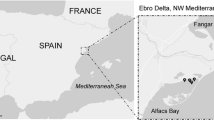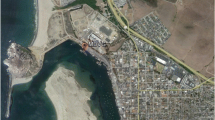Abstract
The large lakes south of the Alps constitute the most important lake district in Italy. In these regions, Tychonema bourrellyi was identified only recently, with anatoxin-a (ATX-a) producing populations developing with high biomasses in spring and early summer. The increasing development of T. bourrellyi and the associated risk for ATX-a exposure may have a negative impact on the use of water resources. In this regard, recent molecular tools proved to be suitable for the analysis and surveillance of toxigenic microorganisms, providing significant advances in water quality management. In this study, we designed species-specific primers based on the rbcLX genes, for the identification and cell quantification of T. bourrellyi in environmental samples, for PCR and qPCR (SYBR Green) applications. The application of this assay for environmental analyses was validated on Lake Garda samples, showing a significant correlation with densities estimated by light microscopy (LM). Moreover, densities estimated by both LM and qPCR were highly correlated with concentrations of ATX-a. This sensitive method can be used for the long-term study of T. bourrellyi population dynamics, and its fast monitoring in the alpine region, improving risk assessment evaluations and the management of waters.




Similar content being viewed by others
References
Al-Tebrineh, J., M. M. Gehringer, R. Akcaalan & B. A. Neilan, 2011. A new quantitative PCR assay for the detection of hepatotoxigenic cyanobacteria. Toxicon 57: 546–554.
Ávila, M. P., P. A. Staehr, F. A. R. Barbosa, E. Chartone-Souza & A. M. A. Nascimento, 2017. Seasonality of freshwater bacterioplankton diversity in two tropical shallow lakes from the Brazilian Atlantic Forest. FEMS Microbiology Ecology 93: 1.
Basu, C., 2015. PCR Primer Design. Humana Press, New york.
Briand, E., M. Gugger, J. C. François, C. Bernard, J. F. Humbert & C. Quiblier, 2008. Temporal variations in the dynamics of potentially microcystin-producing strains in a bloom-forming Planktothrix agardhii (Cyanobacterium) population. Applied and Environmental Microbiology 74: 3839–3848.
Capelli, C., A. Ballot, L. Cerasino, A. Papini & N. Salmaso, 2017. Biogeography of bloom-forming microcystin producing and non-toxigenic populations of Dolichospermum lemmermannii (Cyanobacteria). Harmful Algae 67: 1–12.
Cerasino, L. & N. Salmaso, 2012. Diversity and distribution of cyanobacterial toxins in the Italian subalpine lacustrine district. Oceanological and Hydrobiological Studies 41: 54–63.
Cerasino, L., C. Capelli & N. Salmaso, 2017. A comparative study of the metabolic profiles of common nuisance cyanobacteria in southern perialpine lakes. Advances in Oceanography and Limnology 8: 1.
Chorus, I. (ed.), 2012. Current Approaches to Cyanotoxin Risk Assessment, Risk Management and Regulations in Different Countries (2012). Umweltbundesamt, issue February 2016 (2012):151.
Churro, C., P. Pereira, V. Vasconcelos & E. Valério, 2012. Species-specific real-time PCR cell number quantification of the bloom-forming cyanobacterium Planktothrix agardhii. Archives of Microbiology 194: 749–757.
Crosby, L., & C. Criddle, 2003. Understanding bias in microbial community analysis techniques due to rrn operon copy number heterogeneity. Biotechniques, https://www.researchgate.net/profile/Craig_Criddle/publication/10798202_Understanding_bias_in_microbial_community_analysis_techniques_due_to_rrn_operon_copy_number_heterogeneity/links/09e415061b5f5b3f27000000/Understanding-bias-in-microbial-community-analysis-techniques-due-to-rrn-operon-copy-number-heterogeneity.pdf.
Dolman, A. M., J. Rücker, F. R. Pick, J. Fastner, T. Rohrlack, U. Mischke & C. Wiedner, 2012. Cyanobacteria and cyanotoxins: the influence of nitrogen versus phosphorus. PLoS ONE 7: e38757.
Hall, T., 1999. BioEdit: a user-friendly biological sequence alignment editor and analysis program for Windows 95/98/NT. Nucleic acids symposium series, http://jwbrown.mbio.ncsu.edu/JWB/papers/1999Hall1.pdf.
Humbert, J. F., C. Lyra, A. Couté, M. Gugger, K. Sivonen & P. Henriksen, 2002. Phylogenetic comparison of the cyanobacterial genera Anabaena and Aphanizomenon. International Journal of Systematic and Evolutionary Microbiology 52: 1867–1880.
Köker, L., R. Akçaalan, M. Albay & B. A. Neilan, 2017. Molecular detection of hepatotoxic cyanobacteria in inland water bodies of the Marmara Region, Turkey. Advances in Oceanography and Limnology 8: 1.
Komárek, J., H. Kling & J. Komárková, 2003. Filamentous cyanobacteria. Freshwater Algae of North America 4: 117–196.
Koskenniemi, K., C. Lyra, P. Rajaniemi-Wacklin, J. Jokela & K. Sivonen, 2007. Quantitative real-time PCR detection of toxic Nodularia cyanobacteria in the Baltic Sea. Applied and Environmental Microbiology 73: 2173–2179.
Kurmayer, R. & T. Kutzenberger, 2003. Application of real-time pcr for quantification of microcystin genotypes in a population of the toxic cyanobacterium Microcystis sp. American Society for Microbiology 69: 6723–6730.
Kurmayer, R., E. Schober, L. Tonk, P. M. Visser & G. Christiansen, 2011. Spatial divergence in the proportions of genes encoding toxic peptide synthesis among populations of the cyanobacterium Planktothrix in European lakes. FEMS Microbiology Letters 317: 127–137.
Kurmayer, R., K. Sivonen, A. Wilmotte & N. Salmaso (eds.), 2017. Molecular Tools For The Detection And Quantification Of Toxigenic Cyanobacteria. Wiley, Hoboken.
Ibelings, B. W., L. C. Backer, W. E. A. Kardinaal & I. Chorus, 2014. Current approaches to cyanotoxin risk assessment and risk management around the globe. Harmful Algae 40: 63–74.
Le Bescot, N., F. Mahé, S. Audic, C. Dimier, M.-J. Garet, J. Poulain, P. Wincker, C. de Vargas & R. Siano, 2016. Global patterns of pelagic dinoflagellate diversity across protist size classes unveiled by metabarcoding. Environmental Microbiology 18: 609–626.
Lund, J. W. G., 1955. Contributions to our knowledge of British Algae, XIV. Three new species from the English Lake District. Hydrobiologia 7: 219–229.
Martins, A. & V. Vasconcelos, 2011. Use of qPCR for the study of hepatotoxic cyanobacteria population dynamics. Archives of Microbiology 193: 615–627.
Meriluoto, J., L. Blaha, G. Bojadzija, M. Bormans, L. Brient, G. A. Codd, D. Drobac, E. J. Faassen, J. Fastner, A. Hiskia, B. W. Ibelings, T. Kaloudis, M. Kokocinski, R. Kurmayer, D. Pantelić, A. Quesada, N. Salmaso, N. Tokodi, T. M. Triantis, P. M. Visser & Z. Svirčev, 2017. Toxic cyanobacteria and cyanotoxins in European waters – recent progress achieved through the CYANOCOST Action and challenges for further research. Advances in Oceanography and Limnology 8: 1.
Moreira, C., A. Martins, J. Azevedo, M. Freitas, A. Regueiras, M. Vale, A. Antunes & V. Vasconcelos, 2011. Application of real-time PCR in the assessment of the toxic cyanobacterium Cylindrospermopsis raciborskii abundance and toxicological potential. Applied Microbiology and Biotechnology 92: 189–197.
Neilan, B. A., L. A. Pearson, J. Muenchhoff, M. C. Moffitt & E. Dittmann, 2013. Environmental conditions that influence toxin biosynthesis in cyanobacteria. Environmental Microbiology 15: 1239–1253.
Nierzwicki-Bauer, S., & S. Curtis, 1984. Cotranscription Of Genes Encoding the Small and Large Subunits of Ribulose-1, 5-Bisphosphate Carboxylase in the Cyanobacterium Anabaena 7120. Proceedings of the National Academy of Sciences, 81: 5961–5965, http://www.pnas.org/content/81/19/5961.short.
Pearson, L. A. & B. A. Neilan, 2008. The molecular genetics of cyanobacterial toxicity as a basis for monitoring water quality and public health risk. Current Opinion in Biotechnology 19: 281–288.
Rajaniemi, P., P. Hrouzek, K. Kastovská, R. Willame, A. Rantala, L. Hoffmann, J. J. Komárek, K. Sivonen, K. Kaštovská, R. Willame, A. Rantala, L. Hoffmann, J. J. Komárek, K. Sivonen, K. Kastovská, R. Willame, A. Rantala, L. Hoffmann, J. J. Komárek & K. Sivonen, 2005. Phylogenetic and morphological evaluation of the genera Anabaena, Aphanizomenon, Trichormus and Nostoc (Nostacales, cyanobacteria). International Journal of Systematic and Evolutionary Microbiology 55: 11–26.
R Core Team, 2017. R: A Language and Environment for Statistical Computing. R Foundation for Statistical Computing, Vienna.
Rantala-Ylinen, A., H. Savela, K. Sivonen & R. Kurmayer, 2017. Chapter 7, Quantitative PCR. In Kurmayer, R., K. Sivonen, A. Wilmotte & N. Salmaso (eds.), Molecular Tools for the Detection and Quantification of Toxigenic Cyanobacteria. Wiley, Hoboken.
Rasmussen, J. P., S. Giglio, P. T. Monis, R. J. Campbell & C. P. Saint, 2008. Development and field testing of a real-time pcr assay for cylindrospermopsin-producing cyanobacteria. Journal of Applied Microbiology 104: 1503–1515.
Rudi, K., O. M. Skulberg & K. S. Jakobsen, 1998. Evolution of cyanobacteria by exchange of genetic material among phyletically related strains. Journal of Bacteriology 180: 3453–3461.
Salmaso, N. & R. Mosello, 2010. Limnological research in the deep southern subalpine lakes: synthesis, directions and perspectives. Advances in Oceanography and Limnology 1: 29–66.
Salmaso, N., D. Copetti, L. Cerasino, S. Shams, C. Capelli, A. Boscaini, L. Valsecchi, F. Pozzoni & L. Guzzella, 2014. Variability of microcystin cell quota in metapopulations of Planktothrix rubescens: causes and implications for water management. Toxicon 90: 82–96.
Salmaso, N., C. Capelli, S. Shams & L. Cerasino, 2015. Expansion of bloom-forming Dolichospermum lemmermannii (Nostocales, Cyanobacteria) to the deep lakes south of the Alps: Colonization patterns, driving forces and implications for water use. Harmful Algae 50: 76–87.
Salmaso, N., L. Cerasino, A. Boscaini & C. Capelli, 2016. Planktic Tychonema (Cyanobacteria) in the Large Lakes South of the Alps: phylogenetic Assessment And Toxigenic Potential. FEMS Microbiology Ecology 92: 10.
Salmaso, N., D. Albanese, C. Capelli, A. Boscaini, M. Pindo & C. Donati, 2017. Diversity and cyclical seasonal transitions in the bacterial community in a large and deep Perialpine Lake. Microbial Ecology. https://doi.org/10.1007/s00248-017-1120-x.
Shams, S., C. Capelli, L. Cerasino, A. Ballot, D. R. Dietrich, K. Sivonen & N. Salmaso, 2015. Anatoxin-a producing Tychonema (cyanobacteria) in European waterbodies. Water Research 69: 68–79.
Skulberg, O., & R. Skulberg, 1985. Planktic species of Oscillatoria (Cyanophyceae) from Norway. Characterization and Classification. Algological Studies/Archiv für Hydrobiologie, supplement volumes: 157–174, http://www.schweizerbart.de/papers/algol_stud/detail/38-39/62856/%23.
Su, M., V. Gaget, S. Giglio, M. Burch, W. An & M. Yang, 2013. Establishment of quantitative PCR methods for the quantification of geosmin-producing potential and Anabaena sp. in freshwater systems. Water Research 47: 3444–3454.
Sukenik, A., A. Quesada & N. Salmaso, 2015. Global expansion of toxic and non- toxic cyanobacteria: effect on ecosystem functioning. Biodiversity and Conservation 24: 889–908.
ThermoFisher Scientific, 2016. Real-Time PCR Handbook. Thermo Fisher Scientific Inc., 3rd ed, https://www.thermofisher.com/it/en/home/life-science/pcr/real-time-pcr/qpcr-education/real-time-pcr-handbook.html.
Untergasser, A., H. Nijveen, X. Rao, T. Bisseling, R. Geurts & J. A. M. Leunissen, 2007. Primer3Plus, an enhanced web interface to Primer3. Nucleic Acids Research 35: W71–W74.
Vaitomaa, J., A. Rantala, K. Halinen, P. Tallberg, L. Mokelke, L. Rouhiainen, K. Sivonen, P. Tallberg, L. Mokelke, K. Sivonen, L. Rouhiainen, K. Sivonen, P. Tallberg, L. Mokelke & K. Sivonen, 2003. Quantitative real-time pcr for determination of microcystin synthetase e copy numbers for microcystis and anabaena in lakes. Applied and Environmental Microbiology 69: 7289–7297.
Vasselon, V., F. Rimet, K. Tapolczai & A. Bouchez, 2017. Assessing ecological status with diatoms DNA metabarcoding: scaling-up on a WFD monitoring network (Mayotte island, France). Ecological Indicators 82: 1–12.
Wei, Z., M. Zhu, G. Yu & R. Li, 2012. Occurrence of planktonic cyanobaterium Tychonema bourrellyi in Erhai Lake and its taxonomic studies. Acta Hydrobiologica Sinica 36: 1171–1175.
Yoshida, M., T. Yoshida, Y. Takashima, N. Hosoda & S. Hiroishi, 2007. Dynamics of microcystin-producing and non-microcystin-producing Microcystis populations is correlated with nitrate concentration in a Japanese lake. FEMS Microbiology Letters 266: 49–53.
Zhang, H., G. Song, J. Shao, X. Xiang, Q. Li, Y. Chen, P. Yang & G. Yu, 2016. Dynamics and polyphasic characterization of odor-producing cyanobacterium Tychonema bourrellyi from Lake Erhai, China. Environmental Science and Pollution Research 23: 5420–5430.
Acknowledgements
The activity was supported by PhD fellowship to C. Capelli from the E. Mach Foundation—Istituto Agrario di S. Michele all’Adige. Investigations were carried out in the framework of the LTER (Long Term Ecological Research) Italian network, site ‘Southern Alpine lakes’, IT08-000-A (http://www.lteritalia.it/). We are grateful to our colleagues in FEM, for their support in the field and/or laboratory activities, and to the ARPA Veneto (G. Franzini), for logistic support in the field.
Author information
Authors and Affiliations
Corresponding author
Additional information
Guest editors: Nico Salmaso, Orlane Anneville, Dietmar Straile & Pierluigi Viaroli / Large and deep perialpine lakes: ecological functions and resource management
Electronic supplementary material
Below is the link to the electronic supplementary material.
Rights and permissions
About this article
Cite this article
Capelli, C., Cerasino, L., Boscaini, A. et al. Molecular tools for the quantitative evaluation of potentially toxigenic Tychonema bourrellyi (Cyanobacteria, Oscillatoriales) in large lakes. Hydrobiologia 824, 109–119 (2018). https://doi.org/10.1007/s10750-018-3513-3
Received:
Revised:
Accepted:
Published:
Issue Date:
DOI: https://doi.org/10.1007/s10750-018-3513-3




